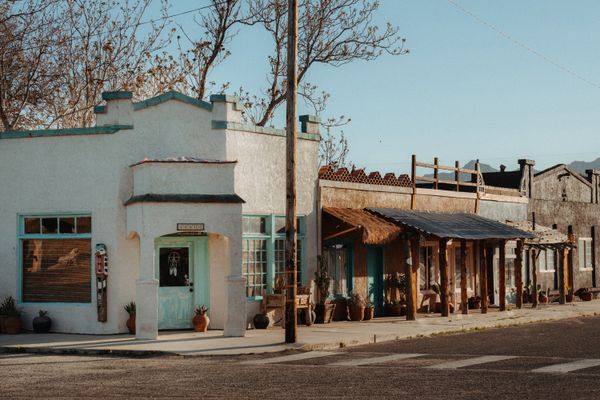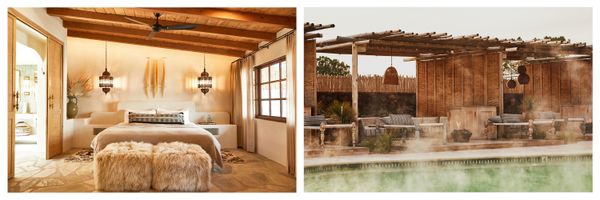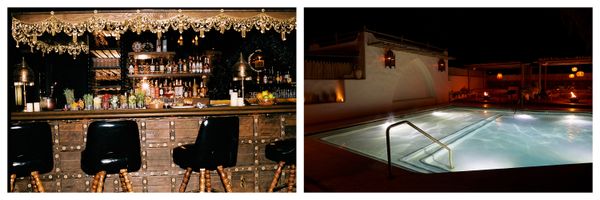The new owners of a historic retreat in Jacumba Hot Springs want to show how transformation in small towns can actually serve the community.
The sun is setting in San Diego’s Sonoran Desert. A dusty fuchsia hue, the color of bougainvilleas, stretches across the sky. The air smells of spices and sulfur. Less than half a mile to the south, the U.S.-Mexico border wall looms with its tall, rusted slats. A couple emerges from a vintage Argosy trailer—its shell painted “Hotel Check-in”—with sand-colored ceramic mugs in hand. Nearby, the freshly renovated Jacumba Hot Springs Hotel blends in with the desert landscape, its adobe-inspired walls and other hallmarks of Pueblo Revival-and Southwestern-style architecture, like exposed vigas, flanked by palms and a xeriscaped courtyard.
The unincorporated community of Jacumba Hot Springs, situated in the mountains of southeastern San Diego County along old Highway 80, has lived many lives, but this hotel has long been its center. Many millennials born and raised in the region (myself included), know Jacumba as a bit of a ghost town in recent decades. The land was originally inhabited by the Kumeyaay people, who organized their way of life around the area’s geothermal hot springs and their therapeutic properties. It became a popular resort destination when the namesake hotel opened in 1925, drawing wellness tourists and Hollywood stars to the area’s healing hot springs and mineral-rich reservoir. (The proximity to Tijuana, famous during the Prohibition era for its jazz clubs with cheap alcohol, didn’t hurt.) At its peak in the 1930s and ’40s, Jacumba was a thriving community with shops, a dance hall, and a railroad stop. But the opening of Interstate 8 in the ’60s diverted traffic, impacting local businesses, and by 1983, a fire destroyed much of the hotel, marking the beginning of a long chapter of decline for the area.

The unincorporated desert community of Jacumba Hot Springs in San Diego County was a thriving outpost for wellness tourism in the 1930s and ’40s.
Photo by Johanna Siring
In 2021, the historic hotel underwent a renovation by real estate investor Jeff Osborne and interior designers Corbin Winters and Melissa Strukel after Strukel and her partner, David Lampley, came across the property while road-tripping during the pandemic lockdown. The three friends turned business partners, who work under the name We Are Human Kind, purchased the 20th-century hotel in late 2020, along with Jacumba’s post office, defunct gas station, man-made lake, and several cabins and storefronts, and moved to the town to commence a yearslong overhaul. “The intention was always to be mindful of the community we’re building,” says Osborne.

Interior designers Melissa Strukel and Corbin Winters and real estate investor Jeff Osborne bought the hotel, along with the town’s mineral lake and a number of other buildings, from Dave and Helen Landman, the longtime owners of most of the properties in Jacumba Hot Springs.
Photos by Mikael Kennedy
They started with the hotel: its restaurant and bar, its three hot springs pools, and its 2o guest rooms, now connected by breezeways and regraded dirt paths. The overall look of the hotel features a recognizably millennial take on desert design—the type of Bedouin meets Mission Revival and Pueblo style that’s now the go-to for Airbnbs in arid climates, as well as hotels that brand themselves as “oases” and appeal in equal measure to Tulum-frequenting influencers and the Burning Man set. In the rooms, vigas (wooden beams used in traditional adobe architecture) and stone floors coexist with shiny brass accents like snake door handles and glossy, textured pastel tiles. California en plein air paintings of desert and chaparral landscapes fill the restaurant walls. In the courtyard, there are hanging brass bells that Winters sourced from Arcosanti, Paolo Soleri’s Arizona desert utopia, which today attracts some millennial and Gen Z travelers interested in architectural (and Instagrammable) landmarks.
The 1970s-style bar, called the “exotic desert hideaway” (a self-aware, quippy nod to the hotel flip), goes with a more tiki-inspired aesthetic that even leans Gothic. There are dark leather banquettes and wood millwork that add to the moody grotto feel of the dimly lit room. The decor also includes Moroccan-style brass lamps and vintage nudie oil paintings that Strukel bought in an auction, which once hung in an iconic San Diego dive bar named Albie’s Beef Inn. (As a San Diego native who drank one too many martinis that tasted like jet fuel at Albie’s, I gasped, then nearly cried when I saw them.)

The We Are Human Kind group’s overhaul of the hotel draws on aesthetic influences from Mexico and Marfa to Morocco.
Photos by Pia Riverola
See the full story on Dwell.com: The Renovated Hot Springs Hotel at the Center of a Forgotten Border Town’s Reinvention
Related stories:



